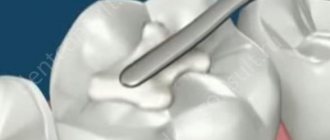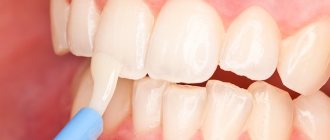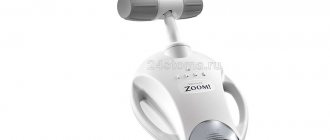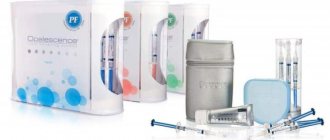Temporary dental crowns are crowns made from inexpensive materials that are used during prosthetics only to protect teeth until permanent crowns are installed.
The purpose of using temporary crowns is to strengthen teeth and give them a natural appearance.
Such crowns are not very stable and have limited aesthetics. They are installed on a previously ground tooth or on an implant.
In what cases are temporary crowns installed?
- When a tooth is chipped or completely lost.
- After root canal treatment.
- In the case where caries has led to weakening and destruction of the tooth crown.
- After implantation.
Three ways to attach crowns or dentures during implantation
- Cement - attachment to the abutment is performed using composite glue. It has good shock-absorbing properties. The most common type of fixation, which simplifies the installation of a bridge consisting of several elements.
- Screw - the crown is secured to the abutment outside the oral cavity. The resulting structure must be screwed into the implant. A technological hole is used through which a screw is screwed. To disguise it, a composite material is used.
- Telescopic - involves the use of double crowns: one is fixed to the abutment, the other is mounted into the body of the prosthesis.
Why are temporary crowns needed?
Before installing a permanent crown on a tooth, you must wait until the mucous membrane has healed. To protect the oral cavity from bacterial infections during this time, temporary crowns were created.
The dentist places a crown, which is bonded to the tooth with special temporary cement so that it can be easily removed when the final crown is ready.
Why is it necessary to put a temporary crown on your teeth?
- A temporary crown protects the ground tooth and ensures patient comfort while ensuring proper aesthetics.
- Preserving the aesthetics of a smile. Temporary crowns are especially often used to cover missing front teeth.
- Protection against hypersensitivity. A ground tooth without enamel protection is sensitive to the pain of temperature changes.
- Bite stabilization. A temporary crown prevents the remaining teeth from shifting.
- Protection of periodontal tissues. A temporary crown is necessary to prevent gingivitis.
- Protection against bacteria arising in the oral cavity.
Manufacturing and installation
Temporary crowns can be made using one of two methods:
The direct method allows you to make a provisional structure in about one hour
Using a softened silicone mass, the dentist makes impressions, after which the tooth is ground down. The doctor pours plastic into the impression and places it on the prepared, ground tooth. After this, the impression is removed, and the hardened plastic product remains in place.
The specialist grinds off excess material from the product, and then polishes and grinds it. The finished product is fixed with dental cement.
The indirect method involves manufacturing the product in the laboratory
Impressions are taken using silicone paste. Two models are made from plaster. A temporary structure is then created using wax. Crowns made by the indirect method are stronger and more reliable, and also best suit the anatomical features of the patient’s jaw. How to organize care?
Since dental restorations are attached with temporary cement, avoid sticky or viscous products that can damage or detach the material from the tooth. In addition, experts recommend reducing the load during chewing on the area of the jaw where the crown is installed.
When brushing your teeth, handle the temporary product carefully to avoid damaging it. Please note that such structures can only be used until a permanent prosthesis is installed. What to do if the temporary product falls out? It is necessary to contact a specialist for re-fixation with temporary cement. At night, it is better to remove the unglued crown from the oral cavity and place it in a glass of water.
Author of the material: Semenova Anna.
Installation of a temporary crown
The placement of a temporary crown is usually completed in one visit to the dental office. The installation process takes about 10-30 minutes. The procedure is painless. Grinding and correction of teeth are performed under local anesthesia.
First, the dentist prepares the tooth for a permanent crown. The tooth surface is ground down approximately 1-2 mm on each side.
Impressions of the teeth are then created. They are sent to a dental prosthetics laboratory, where permanent crowns are created.
While they are being made, the patient is given a temporary plastic crown. Once the dentist has received the finished permanent crown, he places it on the patient's tooth.
During the first days after the procedure, the patient may feel discomfort because the shape of the tooth with a temporary crown may be slightly different from what it was before.
Possible complications and side effects after the procedure:
- Discomfort
- Tooth sensitivity
- Allergic reaction
How to make
There are two methods for making temporary crowns: direct and indirect. The production method largely depends on the indications and wishes of the patient. The indirect method is much more expensive, but this crown is stronger and lasts longer.
Direct manufacturing steps:
- taking an impression of the jaw;
- preparation and grinding of the natural crown and possibly adjacent teeth;
- casting a product from a material according to a cast;
- installation and adjustment of the crown;
- fixing the product with cement.
This method is recommended by dentists if treatment is not planned and it is necessary to protect the tooth from external factors and stress.
The entire procedure takes about two hours.
Tips for using temporary crowns
- Some foods will stick to the temporary crown, so please avoid chewing gum or other sweets and foods.
- Avoid chewing on the side of your jaw where the temporary crown was placed.
- Try to minimize your consumption of hard foods (such as vegetables), which can break the crown.
- Temporary crowns do not last long. Sometimes they may crack, break or fall out. If this happens to you, please contact us immediately, bring the crown with you, we will reinstall it or replace it.
- Do not remove the temporary crown from your mouth. Without it, your teeth may shift and the target crown may not fit.
- Don't brush too hard on a tooth with a temporary crown, and be careful with floss.
Materials for temporary structures
Most often, temporary structures are made of plastic. But some clinics use modern composite materials and acrylic plastics to produce pharmaceutical products. The cost of temporary crowns depends on the type of material, which differ in the following indicators:
- - production time
- — rate of hardening of the material
- — ease of shape modeling
- - possibility of correction
- - degree of strength
- - life time
Kinds
To select adhesive for crowns, you can consult your dentist. However, in this matter, the individual characteristics of the body play an important role, so even taking into account the recommendations, you may need to try several different options and settle on the most suitable one.
What to do if a tooth has rotted under the crown
There are three types of product available, which differ in consistency:
- viscous;
- medium viscosity
- liquid.
The last type of glue consumes more than others, but it is most often chosen by people who have recently undergone the procedure of installing dental crowns. This is due to its ease of use. However, gradually, a person adapts to more viscous compositions, as they dry faster.
Any prosthesis, even a small one, causes discomfort in a person; in addition, it is capable of changing taste perception at first. To shorten the period of adaptation, it is not recommended to immediately use products that contain fragrances.
There are quite a few methods for restoring the beauty of a smile reliably and efficiently. However, almost all of them involve the manufacture of prostheses, which sometimes takes several days.
Installing a ceramic or metal-ceramic crown is a multi-step process that can take from several days to several weeks. What to do with the tooth prepared for permanent construction during this period? While the prosthesis is being made, it can be replaced by a temporary tooth. But often in the process of communicating with patients, we hear questions about the advisability of making temporary crowns, especially when an orthopedic dentist suggests placing a temporary crown for a short time before making a permanent structure.
Patients often wonder why temporary crowns are needed when they can just walk around with their teeth ground for a while. After all, such prostheses are installed only for the duration of orthopedic treatment, but require separate manufacturing.
Until recently, temporary crowns were not considered a necessity. However, over time, it became clear that their use significantly improves the quality of treatment and reduces the likelihood of complications after prosthetics.
The importance of using temporary structures has been proven by numerous studies. A high-quality temporary crown, made of materials with low thermal conductivity, protects the tooth pulp from external irritating factors. The main condition is that the crown must fit tightly to the boundaries of the tooth tissue to prevent saliva from getting under it.
In a healthy, intact tooth, the protective function lies on the enamel. However, in the process of preparing for prosthetics, this tissue is almost completely “cut down”. A tooth treated for a crown is exposed and vulnerable to various irritants (temperature, chemical). Therefore, in a ground tooth, a temporary crown takes on a protective role.
The temporary structure also has an occlusal function. It helps to chew normally and protects gum tissue from mechanical damage from food. In addition, a temporary crown ensures proper contact between teeth, preventing unwanted movements.
Many experts believe that the use of temporary crowns even prevents the development of pathologies of the joints and muscles of the maxillofacial area. It is also important that temporary structures maintain aesthetics during orthopedic treatment. This is especially true for the front teeth.
Usually, before installing a crown or prosthesis, the tooth needs to be ground, and only after grinding can impressions be taken and the manufacture of dentures begin. A ground tooth looks very unsightly and causes both aesthetic and psychological discomfort to the patient.
To restore the aesthetics and functionality of the dentition, temporary, or provisional, crowns are used.
They are especially relevant for the front teeth. However, plastic crowns not only mask visual defects in the dentition.
Functions of temporary crowns
• Temporarily restore the function of the ground tooth;
• Allows you to maintain normal diction;
• Do not allow infection to enter the tissues of the prepared tooth;
• Prevent gum tissue from growing onto the tooth to ensure normal installation of a permanent crown;
• Allow a person to quickly get used to a permanent crown;
• Firmly fix the tooth and prevent it from moving to the sides or staggering;
• Maintains bite, preventing neighboring teeth from taking up free space;
• If a tooth is ground down without removing the nerve, it becomes very sensitive to temperature and chemical stimuli, which can cause pain. A temporary crown protects such a tooth.
What are temporary crowns made of?
Temporary structures are made by a dental technician from monomer plastic in the laboratory or from monomer-free (hypoallergenic) composite plastic by an orthopedic dentist in a clinic. Special fast-hardening plastic is characterized by an external resemblance to the color and texture of natural teeth, because it, like ceramics or filling material, is selected according to color and shape. The temporary structure in the oral cavity looks so natural that many people around you may not notice that you are currently at the stage of prosthetics from an orthopedic dentist. Plastic also has high strength values, which makes it possible to make crowns from it for both front and side teeth. Before metal-ceramic crowns became widespread in dental practice, doctors widely used prosthetics using plastic.
For a temporary structure, fast-hardening dental resin is an ideal material - durable, aesthetic and cheap.
Disadvantages of temporary crowns
Temporary crowns are made very quickly and are quite convenient, but they have a number of disadvantages.
It is because of these shortcomings that they cannot be used as permanent prostheses:
• The material of the temporary crown is porous, which makes it easy for infection to penetrate. If the patient neglects the rules of hygiene, the pathogenic microflora will easily reach the ground tooth, which will lead to the development of an inflammatory process. In addition, even with careful hygiene, harmful substances gradually accumulate in the temporary crown;
• Temporary crowns change color very easily when exposed to certain drinks or foods, such as wine, coffee, strong tea, berries, etc. However, it will not be possible to whiten the temporary crown;
• A temporary crown is not strong enough, it has a very short service life and will simply break over time.
Service life of temporary crowns.
With temporary crowns, a person can walk for quite a long time (from several days to 4-5 months), but not constantly. It is worth remembering that any plastic is a very hygroscopic material that absorbs moisture and pigments well, as a result of which it swells and changes color. Plastic crowns are not intended for constant wear: as practice has shown, this does not lead to anything good. Teeth permanently covered with plastic crowns are destroyed and must soon be removed.
How to care for temporary crowns?
You must remember to follow some rules for caring for temporary structures in the oral cavity. This will help avoid its de-cementing (the appearance of mobility):
- Distribute the load on the teeth so that it is minimal on the side of the temporary crown.
- Avoid eating sticky or hard foods to avoid dislodging or damaging the temporary crown.
- Brush your teeth gently and thoroughly with a medium-hard toothbrush.
- When using dental floss to clean between teeth, do not pull it out, holding both ends with your fingers and pulling the thread down. It’s better to let go of one of its ends and slowly pull the end remaining in your hand away from your face.
- Do not wear the crown for more than the period recommended by your doctor!
Thus, the use of temporary crowns is a necessary intermediate step for the patient himself in any type of prosthetics.
Advantages and disadvantages of cement fixation
Positive points:
- There is no need to prepare an access hole. This provides better aesthetic results. The use of a cement composition for prosthetics of the frontal sections is especially justified.
- Superstructure fit correction. If implantation is carried out carelessly, cement fastening allows you to smooth out all existing flaws. Due to this, it becomes possible to perform prosthetics even with a non-optimal position of the implant.
- Primary fitting can be carried out outside the oral cavity, which increases the accuracy of attachment and eliminates inflammation.
- Lower level of weakening of the adhesion of the abutment to the implant in the long term (compared to the screw type of fastening).
- Better quality of biological functioning.
- Ease of manufacture and installation. If the implant axes diverge by more than 17 degrees, restoration with cement fastening is much easier. The technique is in many ways similar to how bridges are installed.
- No passive fit required compared to screw mounting.
- Tools and materials are cheaper.
Opinion of an orthopedic dentist : “I have been working with cement fixation for many years. This is a simple, economical method. Of course, there is a risk of being unable to control the complete cleaning of the subgingival space from excess cement. It is therefore important to follow basic guidelines regarding the level of immersion of the crown/abutment interface. With cement fastening, this figure should not exceed 0.5 mm.”
The main disadvantage is the difficulty of removing the crown, which means that later, if it is necessary to replace structural elements, you will have to make a new prosthesis. Other reasons that make dentists refuse to use:
- Precision fit cannot be achieved due to the fitting of the prosthesis under hydrostatic pressure alone.
- There is a high risk of excess glue getting deep into adjacent tissues, which can cause serious complications, including peri-implantitis. Remaining cement is difficult to clean.
- In the case of an inaccurate fit between the crown frame and the abutment, saliva may wash out the adhesive over time. Plaque and bacteria will begin to fill the resulting space.
- Low predictability of connecting metal elements compared to the screw fastening method.
Features of cement fixation
Before cementing, it is necessary to take an x-ray and carefully remove any remaining temporary dental adhesive. Cementing makes it possible to circumvent a number of limitations of the screw type of fastening:
- low occlusal stability;
- difficulty in manufacturing restorations with passive fitting.
There are also other features:
- soft tissues are mainly supported by the abutment;
- the crown is seated in such a way that its edge is at the same level or slightly apical to the gingival margin.
Features and Application
Installing temporary structures allows you to solve the following problems:
- masking the stump during the manufacture of a permanent prosthesis;
- maintaining the aesthetics and functionality of the row;
- eliminating the risk of displacement of adjacent units, between which there is an increased space after preparation and turning;
- overgrowth of soft tissues after removal of a damaged tooth is prevented;
- relief of pain and discomfort during the production of a permanent prosthesis.
Temporary crowns made of PMMA material are indicated for installation in the following cases:
- elimination of various aesthetic problems;
- restoration of chewing function;
- prevention of the development of bite problems;
- acceleration of the rehabilitation process, getting used to the artificial tooth;
- obstacle to mechanical damage;
- eliminating problems such as diction disorders;
- protection of the stump from temperature, chemical and other irritants;
- exclusion of mechanical and other damage.
Contraindications:
- bruxism;
- age (not used for children);
- in case of allergic reactions to the plastic used;
- deep bite
How does crown cementation occur?
Fixation is the final stage of prosthetics. Basic actions:
- The prepared abutment is sandblasted to create a rough surface.
- Fitting in progress. Before placing the crown on permanent cement, you need to make sure that it is positioned correctly.
- The inner surface of the prosthesis is coated with dental glue and then placed on the abutment.
- After installing the structure, it is irradiated with a special lamp to speed up the hardening process.
- Carefully remove excess cement if it protrudes from under the crown.
An hour after the procedure, the prosthesis can be loaded. Maximum pressure is allowed every other day.
What is Dental Crown Adhesive?
When a tooth structure is damaged, the orthopedic dentist grinds down its surface, creates an impression of the jaw and makes a customized partial denture - a crown. It is a cap that is placed on the treated remaining tooth. This event restores the dentition and returns the aesthetic appearance of the smile.
To secure the crown, a composition that acts as composite cement is used. It ensures a tight fit of the artificial material to the tooth tissue and firmly fixes it.
The strength of the adhesive increases after it hardens. A person can even eat solid food, brush their teeth, talk, and the crown will remain in place.
Everything you need to know about temporary crowns
If you follow the recommendations of a specialist, the structure will last 5-7 years. But, there are cases when the installed prosthesis remains throughout life.
However, excessive loads can damage the most expensive and durable cements, and the crown falls out. In such a situation, there is a need for re-fixation, and if it is not possible to immediately go to the dental office, you can purchase special glue for crowns at the pharmacy.
Materials
Synthetic polymethyl methacrylate is used for production. It is suitable for long-term wearing, making bridges and single-piece appliances. At the same time, production requires minimal time, the design is strong and reliable. No complex equipment is required; with the direct method, all actions require a minimum of time, that is, production occurs in one step.
Features of the material include the following properties:
- natural look, shine, surface polishing to give naturalness;
- biological compatibility;
- the cost of the design is affordable;
- increased aesthetics, the ability to restore the exact shape of a lost unit.
In what cases is it advisable to install on cement?
- Complete, partial edentia;
- single restoration;
- angulation of implants, during which high aesthetic and functional indicators become impossible;
- several designs with non-parallel mesio-distal or vestibulo-lingual angulation;
- the patient's desire to choose this method himself.
Cement fixation is possible:
- with a height of the upper part of the abutment of 5 mm or more;
- when the height of the attached gum around the structure is at least 3-5 mm;
- if the bone wall volume around the implant neck is at least 2-2.5 mm;
- with a crown-to-body height ratio of at least 1:1.5;
- antagonist teeth are in the correct position.











